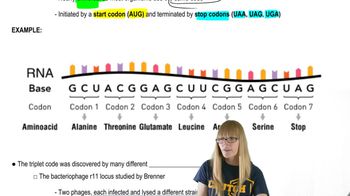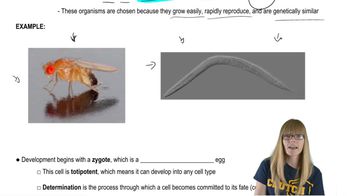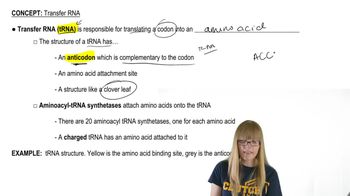Assuming the genetic code is a triplet, what effect would the addition or loss of two nucleotides have on the reading frame? The addition or loss of three, six, or nine nucleotides?
Table of contents
- 1. Introduction to Genetics51m
- 2. Mendel's Laws of Inheritance3h 37m
- 3. Extensions to Mendelian Inheritance2h 41m
- 4. Genetic Mapping and Linkage2h 28m
- 5. Genetics of Bacteria and Viruses1h 21m
- 6. Chromosomal Variation1h 48m
- 7. DNA and Chromosome Structure56m
- 8. DNA Replication1h 10m
- 9. Mitosis and Meiosis1h 34m
- 10. Transcription1h 0m
- 11. Translation58m
- 12. Gene Regulation in Prokaryotes1h 19m
- 13. Gene Regulation in Eukaryotes44m
- 14. Genetic Control of Development44m
- 15. Genomes and Genomics1h 50m
- 16. Transposable Elements47m
- 17. Mutation, Repair, and Recombination1h 6m
- 18. Molecular Genetic Tools19m
- 19. Cancer Genetics29m
- 20. Quantitative Genetics1h 26m
- 21. Population Genetics50m
- 22. Evolutionary Genetics29m
11. Translation
The Genetic Code
Problem 5
Textbook Question
In studies using repeating copolymers, AC . . . incorporates threonine and histidine, and CAACAA . . . incorporates glutamine, asparagine, and threonine. What triplet code can definitely be assigned to threonine?
 Verified step by step guidance
Verified step by step guidance1
Step 1: Understand the problem. The question is asking to determine the triplet codon that codes for threonine based on the incorporation of amino acids from repeating copolymers AC... and CAACAA....
Step 2: Analyze the repeating copolymer AC.... This copolymer alternates between adenine (A) and cytosine (C). When translated, it produces threonine and histidine. This suggests that threonine is coded by one of the triplets formed by AC....
Step 3: Analyze the repeating copolymer CAACAA.... This copolymer alternates between cytosine (C), adenine (A), and repeats. When translated, it produces glutamine, asparagine, and threonine. This suggests that threonine is coded by one of the triplets formed by CAACAA....
Step 4: Compare the triplets formed by AC.... and CAACAA.... The triplets formed by AC.... are ACA and CAC, while the triplets formed by CAACAA.... are CAA, AAC, and ACA. Since ACA appears in both copolymers and incorporates threonine, ACA can be definitively assigned to threonine.
Step 5: Conclude that the triplet codon ACA is the definitive code for threonine based on the overlap between the amino acids produced by the two copolymers.
 Verified video answer for a similar problem:
Verified video answer for a similar problem:This video solution was recommended by our tutors as helpful for the problem above
Video duration:
3mPlay a video:
Was this helpful?
Key Concepts
Here are the essential concepts you must grasp in order to answer the question correctly.
Genetic Code
The genetic code is a set of rules that defines how the sequence of nucleotides in DNA or RNA is translated into the sequence of amino acids in proteins. It consists of triplet codons, where each codon corresponds to a specific amino acid or a stop signal during protein synthesis. Understanding the genetic code is essential for determining which codons correspond to specific amino acids, such as threonine.
Recommended video:
Guided course

The Genetic Code
Amino Acids and Their Codons
Amino acids are the building blocks of proteins, and each amino acid is encoded by one or more specific codons in the genetic code. Threonine, for example, is encoded by the codons ACU, ACC, ACA, and ACG. Recognizing the relationship between amino acids and their corresponding codons is crucial for answering questions about protein synthesis and genetic translation.
Recommended video:
Copolymers in Genetic Studies
Copolymers are molecules made from two or more different monomers, and in genetic studies, they can be used to investigate the incorporation of specific amino acids into proteins. The mention of repeating copolymers in the question suggests a focus on how these structures can influence the incorporation of amino acids like threonine and histidine. Understanding the role of copolymers helps in analyzing how specific sequences can lead to the synthesis of proteins with desired properties.
Recommended video:
Guided course

Genetics of Development
Related Videos
Related Practice
Textbook Question
804
views



